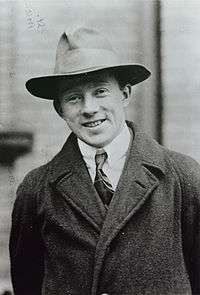Heisenberg picture

In physics, the Heisenberg picture (also called the Heisenberg representation[1]) is a formulation (largely due to Werner Heisenberg in 1925) of quantum mechanics in which the operators (observables and others) incorporate a dependency on time, but the state vectors are time-independent, an arbitrary fixed basis rigidly underlying the theory.
It stands in contrast to the Schrödinger picture in which the operators are constant, instead, and the states evolve in time. The two pictures only differ by a basis change with respect to time-dependency, which corresponds to the difference between active and passive transformations. The Heisenberg picture is the formulation of matrix mechanics in an arbitrary basis, in which the Hamiltonian is not necessarily diagonal.
It further serves to define a third, hybrid, picture, the Interaction picture.
Mathematical details
In the Heisenberg picture of quantum mechanics the state vectors, |ψ(t)〉, do not change with time, while observables A satisfy
where H is the Hamiltonian and [•,•] denotes the commutator of two operators (in this case H and A). Taking expectation values automatically yields the Ehrenfest theorem, featured in the correspondence principle.
By the Stone–von Neumann theorem, the Heisenberg picture and the Schrödinger picture are unitarily equivalent, just a basis change in Hilbert space. In some sense, the Heisenberg picture is more natural and convenient than the equivalent Schrödinger picture, especially for relativistic theories. Lorentz invariance is manifest in the Heisenberg picture, since the state vectors do not single out the time or space.
This approach also has a more direct similarity to classical physics: by simply replacing the commutator above by the Poisson bracket, the Heisenberg equation reduces to an equation in Hamiltonian mechanics.
Equivalence of Heisenberg's equation to the Schrödinger Equation
For the sake of pedagogy, the Heisenberg picture is introduced here from the subsequent, but more familiar, Schrödinger picture. The expectation value of an observable A, which is a Hermitian linear operator, for a given Schrödinger state |ψ(t)〉, is given by
In the Schrödinger picture, the state |ψ(t)〉at time t is related to the state |ψ(0)〉at time 0 by a unitary time-evolution operator, U(t),
If the Hamiltonian does not vary with time, then the time-evolution operator can be written as
where H is the Hamiltonian and ħ is the reduced Planck constant. Therefore,
Peg all state vectors to a rigid basis of |ψ(0)〉then, and define
It now follows that
Differentiation was according to the product rule, while ∂A/∂t is the time derivative of the initial A, not the A(t) operator defined. The last equation holds since exp(−iHt/ħ) commutes with H.
Thus
and hence emerges the above Heisenberg equation of motion, since the convective functional dependence on x(0) and p(0) converts to the same dependence on x(t), p(t), so that the last term converts to ∂A(t)/∂t . [X, Y] is the commutator of two operators and is defined as [X, Y] := XY − YX.
The equation is solved by the A(t) defined above, as evident by use of the standard operator identity,
which implies
This relation also holds for classical mechanics, the classical limit of the above, given the correspondence between Poisson brackets and commutators,
In classical mechanics, for an A with no explicit time dependence,
so, again, the expression for A(t) is the Taylor expansion around t = 0.
In effect, the arbitrary rigid Hilbert space basis |ψ(0)〉has receded from view, and is only considered at the very last step of taking specific expectation values or matrix elements of observables.
Commutator relations
Commutator relations may look different than in the Schrödinger picture, because of the time dependence of operators. For example, consider the operators x(t1), x(t2), p(t1) and p(t2). The time evolution of those operators depends on the Hamiltonian of the system. Considering the one-dimensional harmonic oscillator,
- ,
the evolution of the position and momentum operators is given by:
- ,
- .
Differentiating both equations once more and solving for them with proper initial conditions,
leads to
- ,
- .
Direct computation yields the more general commutator relations,
- ,
- ,
- .
For , one simply recovers the standard canonical commutation relations valid in all pictures.
Summary comparison of evolution in all pictures
| Evolution | Picture | ||
| of: | Heisenberg | Interaction | Schrödinger |
| Ket state | constant | ||
| Observable | constant | ||
| Density matrix | constant | ||
See also
References
- ↑ "Heisenberg representation". Encyclopedia of Mathematics. Retrieved 3 September 2013.
- Cohen-Tannoudji, Claude; Bernard Diu; Frank Laloe (1977). Quantum Mechanics (Volume One). Paris: Wiley. pp. 312–314. ISBN 0-471-16433-X.
- Albert Messiah, 1966. Quantum Mechanics (Vol. I), English translation from French by G. M. Temmer. North Holland, John Wiley & Sons.
- Merzbacher E., Quantum Mechanics (3rd ed., John Wiley 1998) p.430-1 ISBN 0-471-88702-1
- L.D. Landau, E.M. Lifshitz (1977). Quantum Mechanics: Non-Relativistic Theory. Vol. 3 (3rd ed.). Pergamon Press. ISBN 978-0-08-020940-1. Online copy
- R. Shankar (1994); Principles of Quantum Mechanics, Plenum Press, ISBN 978-0306447907 .
- J. J. Sakurai (1993); Modern Quantum mechanics (Revised Edition), ISBN 978-0201539295 .
External links
- Pedagogic Aides to Quantum Field Theory Click on the link for Chap. 2 to find an extensive, simplified introduction to the Heisenberg picture.